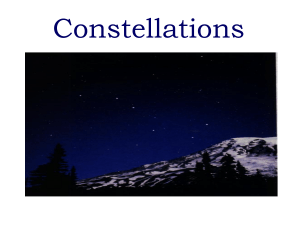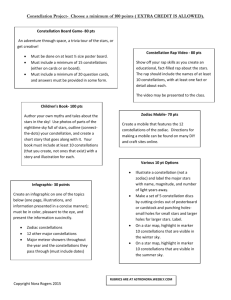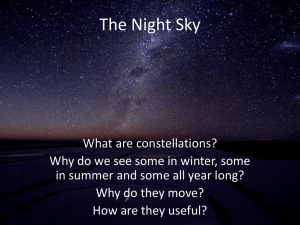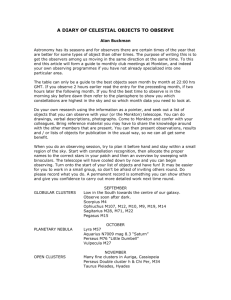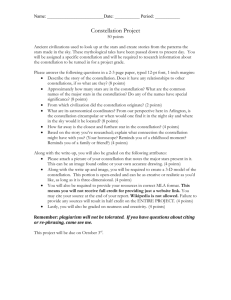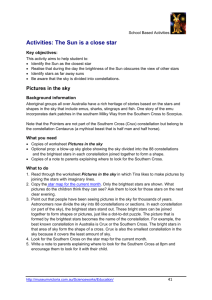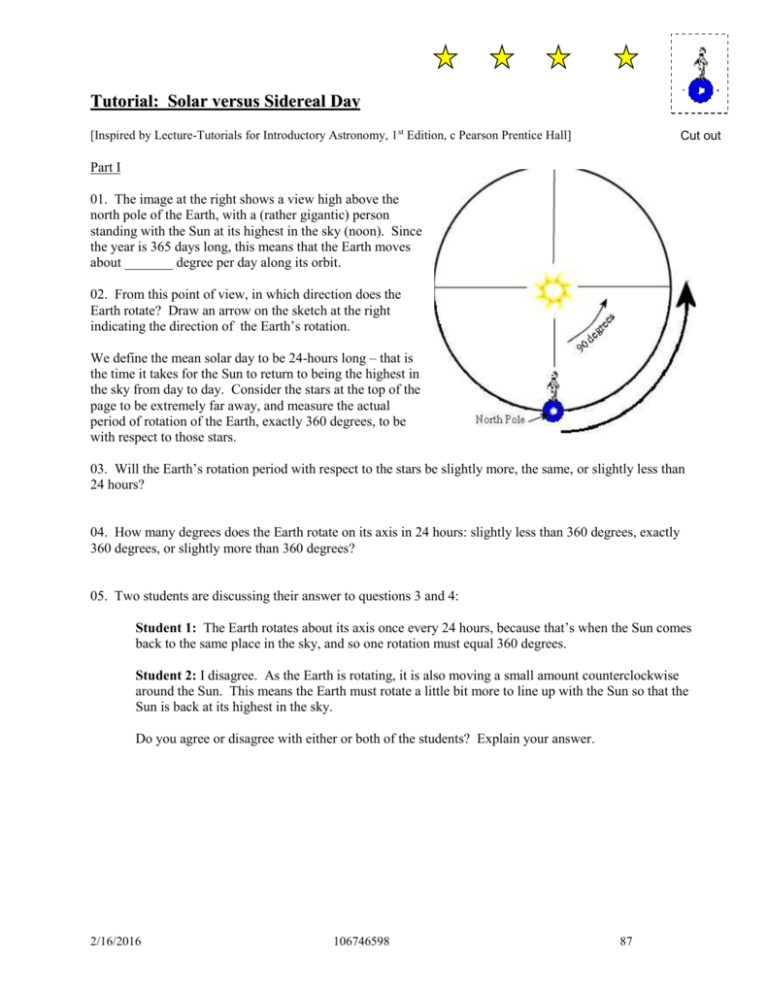
Tutorial: Solar versus Sidereal Day
[Inspired by Lecture-Tutorials for Introductory Astronomy, 1 st Edition, c Pearson Prentice Hall]
Cut out
Part I
01. The image at the right shows a view high above the
north pole of the Earth, with a (rather gigantic) person
standing with the Sun at its highest in the sky (noon). Since
the year is 365 days long, this means that the Earth moves
about _______ degree per day along its orbit.
02. From this point of view, in which direction does the
Earth rotate? Draw an arrow on the sketch at the right
indicating the direction of the Earth’s rotation.
We define the mean solar day to be 24-hours long – that is
the time it takes for the Sun to return to being the highest in
the sky from day to day. Consider the stars at the top of the
page to be extremely far away, and measure the actual
period of rotation of the Earth, exactly 360 degrees, to be
with respect to those stars.
03. Will the Earth’s rotation period with respect to the stars be slightly more, the same, or slightly less than
24 hours?
04. How many degrees does the Earth rotate on its axis in 24 hours: slightly less than 360 degrees, exactly
360 degrees, or slightly more than 360 degrees?
05. Two students are discussing their answer to questions 3 and 4:
Student 1: The Earth rotates about its axis once every 24 hours, because that’s when the Sun comes
back to the same place in the sky, and so one rotation must equal 360 degrees.
Student 2: I disagree. As the Earth is rotating, it is also moving a small amount counterclockwise
around the Sun. This means the Earth must rotate a little bit more to line up with the Sun so that the
Sun is back at its highest in the sky.
Do you agree or disagree with either or both of the students? Explain your answer.
2/16/2016
106746598
87
Part II
Using the figure just below, let’s take it to an extreme and see if we can still figure it out for many, many
days. (It is high noon on the equator for the stick figure in this image at both times.)
06. How many months have passed between these two
times? How many days approximately?
07. How many rotations of the Earth with respect to the
Sun have occurred?
08. How many rotations with respect to the stars “really,
really far away” have occurred?
09. If a star rose in the east for someone somewhere on
Earth midnight at time A, at what time would that same star
rise for that same person at time B? [Approx.]
10. Last night you saw the star Betelgeuse (indicated by the arrow in
the image at the left) just rising above the eastern horizon at 6:42 pm
PST. You were so excited, you want to go back out again and catch the
star just as it is rising above the eastern horizon. Will you need to go
out earlier than, later than, or precisely at 6:42 pm to see Betelgeuse just
rising?
11. You overhear two nearby students discussing their answers to
question 10.
Student 1: The Earth makes one complete rotation about its axis each
day, so Betelgeuse has to rise at the same time every night, all
throughout the year.
Student 2: I disagree. Because the Earth moves around the Sun, the constellation Orion rises earlier each
month, and so it and its stars must rise a little bit earlier each night. At 6:42 pm, Betelgeuse will actually be
higher above the eastern horizon, not just rising.
Do you agree or disagree with either or both of the students? Explain.
88
Tutorial: Seasonal Constellations
Don’t worry about precise answers for the following questions, the perspective makes it difficult to
judge exactly. Just strive to get the main ideas.
01. If the Sun is “in” Cancer in August,
when is the Sun “in” Sagittarius?
02. How many months pass before the Sun
is in Cancer again?
For the rest of this tutorial, it is helpful to
imagine (as we can realistically in our
planetarium) that the stars are so bright or
the Sun so dim (maybe a total eclipse of
the Sun?) that you can see both the Sun and the stars.
Constellations seen at night
change throughout the year.
At noon on October 1, you see the Sun in the
constellation of Virgo, high in the southern sky.
03. At 4 pm that afternoon, will the Sun appear
among the stars of Leo, Virgo, or Libra?
04. Two of your classmates are discussing their
answers to question 3.
Student 1: The Sun will have moved to the
constellation of Leo, since Leo is towards the
west if we’re looking south.
Student 2: You’re forgetting that the Sun moves from the west to the east along the ecliptic during
the course of the year, so the Sun will be almost in the constellation of Libra by 4 pm.
Do you agree or disagree with either or both of the students? Explain your answer.
89
Questions (taken from instructor’s manual for the Lecture Tutorials, CAPER team, preliminary
edition):
01. Which takes longer to complete:
a) one solar day
b) one sidereal day
c) both take the same amount of time.
02. Imagine that the Earth begins orbiting the Sun at twice the pace it does now, completing a year
in only 6 of our current months. In this case, what happens to the length of the solar day?
a) it gets slightly longer
b) it does not change
c) it gets slightly shorter
03. One night you see the star Sirius move across the meridian (that imaginary line that runs from
the north, through your zenith, to the south – splitting the eastern and western sky hemispheres) at
exactly 11:30 pm PST. The following night, Sirius will cross the meridian
a) slightly earlier than 11:30 pm
b) right at 11:30 pm
c) slightly later than 11:30 pm
04. One evening at midnight you observe the constellation of Leo high in the southern sky at
midnight. Virgo is to the east of Leo and Cancer is to the west. One month earlier, which of these
constellations was high in the southern sky at midnight?
a) Virgo
b) Leo
c) Cancer
05. What component of the Earth’s motion causes the stars to rise earlier on successive nights?
a) its rotation about its axis
b) its orbit around the Sun
c) the 23.5 degree tilt of its rotation axis
90



